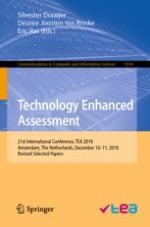2019 | Book
Technology Enhanced Assessment
21st International Conference, TEA 2018, Amsterdam, The Netherlands, December 10–11, 2018, Revised Selected Papers
Editors: Silvester Draaijer, Desirée Joosten-ten Brinke, Eric Ras
Publisher: Springer International Publishing
Book Series : Communications in Computer and Information Science
